Leveraging user behaviour insights to drive user growth for protocols
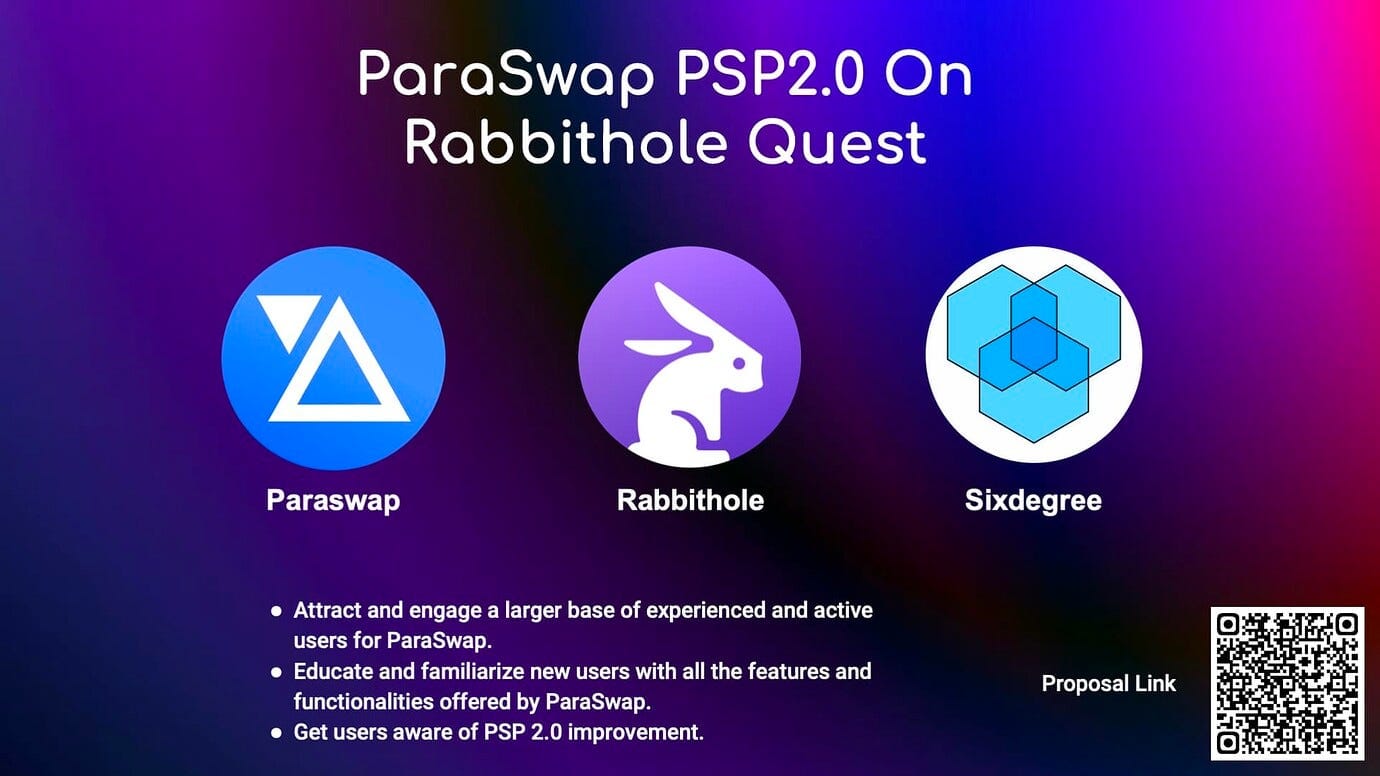
Background
- Founded in summer 2022, the Sixdegree team is composed of data scientists and crypto researchers with experience working with 20+ protocols such as Lens, ParaSwap, Gnosis Safe among others, as well as publishing 60+ Dune dashboards and being ranked No.1 on Dune team leaderboard: https://dune.com/browse/teams 1.
- As Sixdegree evolved from Dune wizards to a data driven growth consultants, we wanted to shed some light on one of our key solutions: user behaviour insights to drive user growth for protocols
- We are always keen to connect with new partners and answer any questions
- Contact us at [email protected] or on twitter https://twitter.com/SixdegreeLab
Overview of how Sixdegree leverages user behaviour insights to driver user growth for protocols
Peers review - What does the market look like? What KPIs can be improved?
- The goal is to compare specific protocols against its peers
- The review aims to uncover any patterns and gaps based on specific KPIs
- Note, the KPIs vary based on sectors, stage and protocols
For example, if we take an example of DEX aggregators, we would look at multiple items such as
- Average trade amount ($)
- Average growth rate of user number (n)
- Frequency
- Retention over time
Assessment and recommendations
- Once we have the result of our data driven analysis, we will look to express recommendations and data-driven quests.
The key principles of quest design include:
- Cultivating a user habit of utilizing a specific protocols.
- Implementing data-driven and easily measurable designs.
- Ensuring the quests are designed to be sustainable, rewarding users more as they engage for a longer duration.
- Providing generous incentives for long-term interaction with the protocol, such as encouraging frequent small swaps over a single large transaction.
Quests Designs
Design philosophy
- Description of the quest goal including actions, duration and expected long term impact. .
Quest design
- Description of the initial aspect of the quest design such as staking and referrals with breakdown
-----------------------------------------------------------------------------------------------------
Case study with ParaSwap proposal
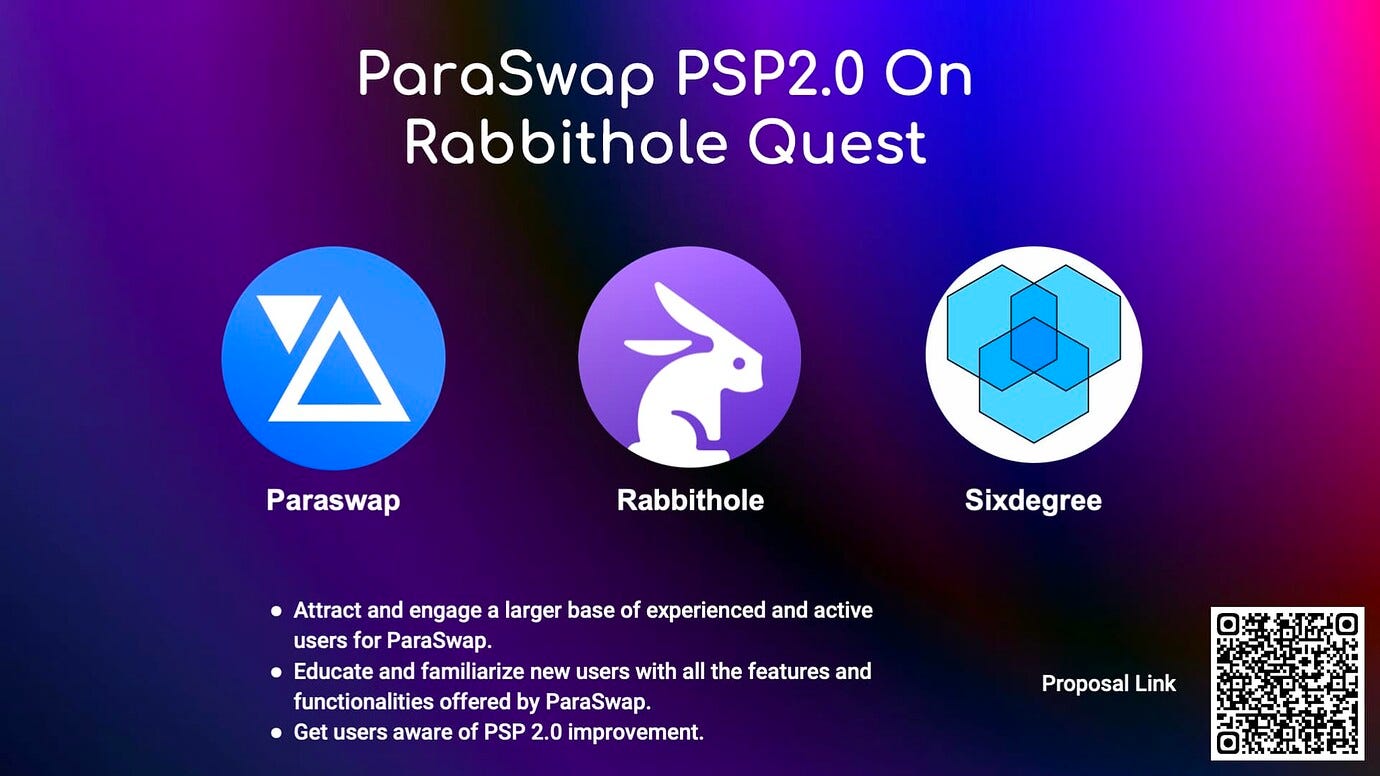
Abstract
- ParaSwap’s recent launch on the Optimism network provides the perfect timing to showcase PSP 2.0 and its expanded capabilities on a new blockchain.
- Quest Terminal, a data-driven quest design platform by Rabbithole, offers a unique opportunity to bootstrap ParaSwap on Optimism.
- Sixdegree aims to leverage Quest Terminal to design compelling quests and incentive programs for ParaSwap.
- We are applying for a grant to be dedicated to quest rewards($15,000 in OP + matching PSP, including 10% of Sixdegree management fee).
- The primary objective is to foster sustainable organic growth for ParaSwap on Optimism by encouraging active participation and engagement.
- Continuous monitoring and community updates of quest data will demonstrate the positive impact of these initiatives.
- The iterative feedback loop based on quest data ensures effective alignment with the desired goals and objectives.
Background Review
PSP 2.0 Upgrade
PSP 2.0 is a major update to improve the tokenomics of PSP. It aims to create a more inclusive and rewarding experience for users and establish a sustainable distribution strategy. The update focuses on enhancing staking efficiency, liquidity, and token emissions.
The new Social Escrow staking system for PSP (sePSP) is designed to incentivize PSP stakers for contributing to the protocol and DAO’s growth. Basically, it expands the idea of veNomics and rewards other socially-positive actions like liquidity pooling. These actions boost your stake, and in exchange you receive real yield in ETH.
Rabbithole Quest Terminal
Rabbithole is an incentive platform to bootstrap projects and networks, enjoying a great reputation in the crypto space. In May 2023, Rabbithole introduced the Quest Terminal 7, a cutting-edge platform that revolutionizes airdrop programs through high-velocity experiments called “quests”. This platform is designed to drive innovation and growth by enabling projects and token holders to engage in rapid and phased experimentation.
The Quest Terminal provides an all-in-one on-chain solution for creating quests and distributing ERC20 tokens as micro rewards seamlessly and efficiently. With this platform, quest creators have the power to easily design and launch quests, allowing them to explore different approaches and iterate quickly.
Moreover, the platform offers real-time metrics of quest performance, offering valuable insights into participant behavior. This data equips quest creators with the knowledge they need to make informed decisions, optimize quest designs, and maximize the impact of their experiments.
Motivation
Recently, ParaSwap has been launched on Optimism, marking a significant milestone. This presents a golden opportunity to promote PSP 2.0 and highlight its release on a new blockchain network!
We, Sixdegree Lab, are excited to offer our assistance in designing quests and incentive programs for ParaSwap on the Quest Terminal platform. Our aim is to facilitate the rapid growth of ParaSwap on Optimism and encourage the engagement of genuine users.
We believe that utilizing Quest Terminal as a platform presents a unique opportunity to incentivize and educate users effectively. By leveraging its data-driven capabilities, we can swiftly iterate on quests and ensure that the incentives provided truly bring value to projects, all while avoiding the sole attraction of airdrop farmers.
Sixdegree will take responsibility for designing weekly quests and monitoring associated data. We are looking forward to a sustainable way to make ParaSwap the top priority when swapping on Optimism. Additionally, we will provide regular blog updates to keep the community informed about the quest’s progress and the positive impact it delivers.
Some background about Sixdegree Lab
Founded in summer 2022, Sixdegree is a team composed of data scientists and crypto researchers with experience working with 20+ protocols such as Lens, ParaSwap, Gnosis Safe, Y-combinator among others as well as publishing 60+ Dune dashboards and ranked No.1 on Dune team leaderboard: https://dune.com/browse/teams 1.
Previous work we’ve done for ParaSwap:
- ParaSwap insight: https://dune.com/sixdegree/paraswap-insight 1
- ParaSwap PSP 2.0 General Metrics:https://dune.com/sixdegree/paraswap-psp-20-general-metrics
- ParaSwap ParaBoost Tracking: https://dune.com/sixdegree/paraswap-paraboost-tracking 1
- ParaSwap YTD Stats 2023: https://dune.com/sixdegree/paraswap-ytd-stats 1
Means - Mandate and Scope
Our ultimate goal is to position ParaSwap as the leading DEX aggregator by enhancing its competitiveness. The chart below illustrates a comparison between ParaSwap and other aggregators in terms of volume, growth rate, etc…


We have identified two main targets for ParaSwap (Optimism) quest design:
- Organic Growth
- Increase the number of new users joining ParaSwap.
- Drive higher trading volumes/ more transactions on the platform.
- Enhance user loyalty and engagement.
- Improve user retention rate.
- PSP 2.0 Awareness
- Encourage more users to stake their PSP tokens.
- Promote socially active behaviors through ParaBoost.
* Encourage trading activities.
* Facilitate market making.
* Promote participation in token pooling.
* Motivate users to refer ParaSwap to others.The key principles of quest design include:
- Cultivating a user habit of utilizing ParaSwap.
- Implementing data-driven and easily measurable designs.
- Ensuring the quests are designed to be sustainable, rewarding users more as they engage for a longer duration.
- Providing generous incentives for long-term interaction with ParaSwap, such as encouraging frequent small swaps over a single large transaction.
To accomplish our objectives, we will divide the quest design into two parts:
- Encouraging increased staking of PSP tokens
- Users who stake a specified amount of PSP tokens (either in sePSP1 or sePSP2) for a defined period (e.g., 3 epochs) will be eligible for rewards.
- We also offer a referral program where the size of the prize increases with the number of users one invites.
- Promoting ParaSwap as the preferred aggregator
- Implement all the recommended strategies by ParaBoost to gain a comprehensive understanding of maximizing rewards under the PSP 2.0 staking system.
- We will create tailored quests that align with various user profiles, encouraging them to adopt ParaSwap as their go-to aggregator.
More details are disclosed in the following chapters.
Part 1 - Staking
There are two forms of staking introduced by PSP2.0:
- sePSP1 - PSP Staking
Single-sided staking of PSP: the most basic form of staking for those who do not want to risk impermanent loss from asset pooling.
- sePSP2 - Liquidity Pool Staking
Liquidity pair of 80/20 PSP-ETH: to incentivize sePSP2 staking, a 2.5x boost on PSP staking is applied. This results in a 2x valuation increase of the value compared to sePSP1.
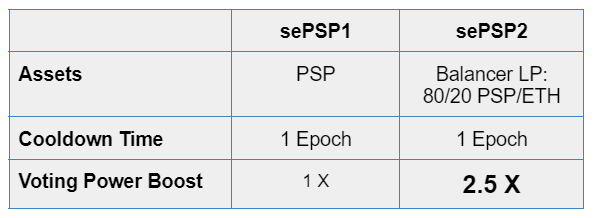
Design philosophy
Staking is an essential requirement for unleashing the full potential of PSP 2.0. To introduce new users to ParaSwap, we will encourage them to initiate their journey by swapping for PSP tokens. Our goal is to motivate users to engage in staking PSP for an extended period of time, surpassing a minimum duration of 2 epochs. By doing so, they will be able to claim their actual yield in ETH, elevating their experience with PSP 2.0. Staking is the key to unlocking an enchanting experience with PSP 2.0.
Quest design
The initial aspect of quest design will primarily revolve around staking and referrals. Here’s a breakdown of each component:
Staking:
- Stake PSP in either sePSP1 or sePSP2. Those who choose providing liquidity in sePSP2 will be entitled to greater rewards.
- It’s important to note that rewards can only be claimed after a certain period, such as 2 epochs.
Referral:
- We aim to foster an environment where those who possess a deep understanding of PSP 2.0 can share their knowledge with others.
- To motivate more participation, we will establish a leaderboard to reward active invites.
Part 2 - ParaBoost
Design philosophy
The main target is to raise awareness of the socially escrow staking system, particularly ParaBoost, which incentivizes users to perform actively on ParaSwap and earn rewards.
To evaluate users’ understanding of PSP 2.0 and their level of engagement with ParaSwap, we will create a matrix that describes user profiles based on their behavior on the platform, as the schematic diagram shown below. The matrix will include the following key factors:
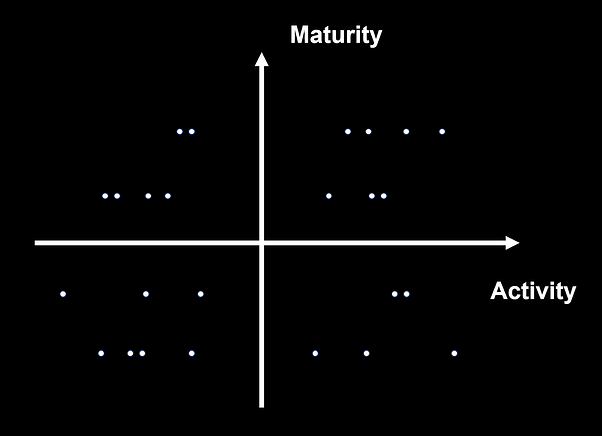
Maturity
- Maturity is determined by a user’s utilization of features and social actions on ParaSwap.
- Currently, ParaSwap offers four basic swap features: Swap, Transfer, Limit, and OTC.
- ParaBoost incentivizes four types of actions: Trading, Market Making, Pooling, and Referrals.
- A user’s maturity level increases with the number of features used and the extent of participation in these actions.
Activity
- Activity measures the frequency of a user’s interactions with ParaSwap.
- Interactions include both swaps and ParaBoost actions.
- Activity will be calculated on a monthly basis, providing a clear indication of user engagement.
By analyzing the user profiles based on these metrics, we can assess the effectiveness of PSP 2.0 in terms of user understanding and active involvement with ParaSwap. This will help us identify areas for improvement and potential strategies to increase user engagement.
User Analysis & Quest design
We propose creating customized quests tailored to different target users based on our matrix. All users will be categorized into four types based on our matrix criteria.
Type 1: Less mature, highly active (1.5x rewards)
- This group consists of users who exhibit high stickiness but may not have fully explored the potential of ParaSwap. To enhance their understanding and guide them towards utilizing PSP 2.0 for improved yields and a deeper protocol comprehension, we will design quests with the following objectives:Encourage participation in various ParaBoost actions, with increasing rewards based on the number of actions undertaken.
- Introduce and incentivize the utilization of swap features that users have not yet explored. For instance, users who utilize an unfamiliar feature such as the OTC feature will earn rewards upon trying it.
Type 2: Highly mature, less active (1.2x rewards)
- This group comprises users who are well-acquainted with ParaSwap and PSP 2.0 but exhibit lower levels of stickiness. To foster their engagement and encourage habitual usage of ParaSwap, we propose the following quest:Utilize ParaSwap for consecutive weeks, engaging in at least one swap per week.
- The longer the duration of continuous usage, the rewards will increase exponentially.
Type 3: Less mature, less active (1x rewards)
- This category primarily consists of users who are new to ParaSwap and require education and encouragement to familiarize themselves with the platform and develop regular usage habits. To achieve this, the proposed quests for this group are as follows: Completion of both the tasks mentioned above.
- Type 4: Highly mature, highly active (2x rewards)
- This group consists of perfect ParaSwap users who possess in-depth knowledge of the project and actively employ ParaSwap as their primary swapping aggregator in their day-to-day activities.
Note:
- To enhance user participation on ParaSwap, we have introduced a distinct bonus for each user category.
- The quest will span a duration of 3 months, during which we will take snapshots and reclassify users based on their performance in the previous month.
- The original user type is determined by analyzing the activity of the same wallet address on the Ethereum mainnet.
- Consequently, a new user is defined as a wallet that has never engaged with ParaSwap on the Ethereum mainnet.
- All new users will be classified as type 3.
Current ParaSwap user matrix on Ethereum
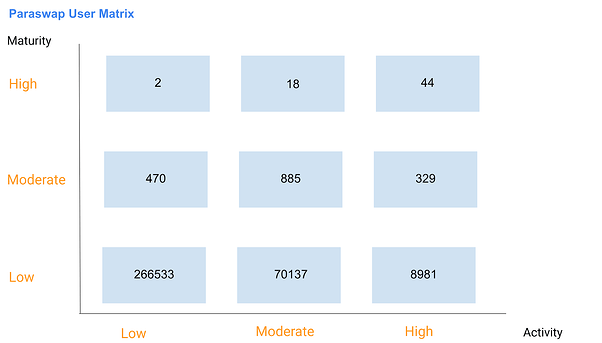
We analyze the current user matrix on Ethereum as an example. It is evident that the majority of current users would greatly benefit from enhanced guidance to fully embrace ParaSwap’s capabilities. The majority of users fall into the category of type 3 users, indicating a need for increased support and education regarding PSP 2.0. Despite Ethereum accounting for 60% of the total trading volume across all chains, there remains significant potential for improvement in this area.
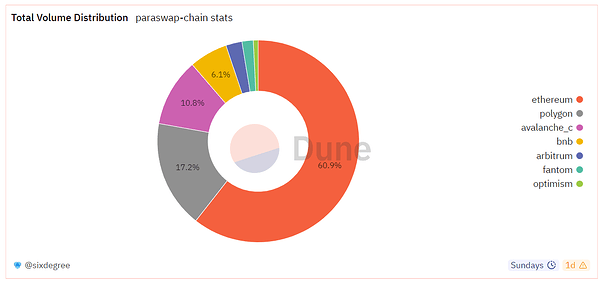
ParaSwap users:
- This includes all users who directly or indirectly interact with the ParaSwap contract.
- Direct connection refers to users who perform actions like swaps directly with the ParaSwap smart contract.
- Indirect connection refers to users who use other protocols, such as Metamask: Swap Router, which indirectly involves ParaSwap in the process. For example, in this transaction: https://etherscan.io/tx/0x75a7b04a4bd5898116927ace7f11472ae1bde72fa44f1b191fe9181bef29af95.
Activity:
- Low activity: Monthly average transactions with ParaSwap <= 1.
- Moderate activity: Monthly average transactions with ParaSwap between 1 and 4.
- High activity: Monthly average transactions with ParaSwap >= 4.
Maturity:
We assign a maturity score to each user based on meeting the following conditions, with each condition earning 1 point:
- Staking PSP in sePSP1.
- Staking PSP in sePSP2.
- Trading on ParaSwap in at least 2 different months or conducting 4 or more trades.
- Holding PSP tokens in the wallet worth more than 100 USD.
- Low maturity: score <=1
- Moderate maturity: score = 2 or 3
- High maturity: score >= 4
Aggregator User Breakdown by Activity
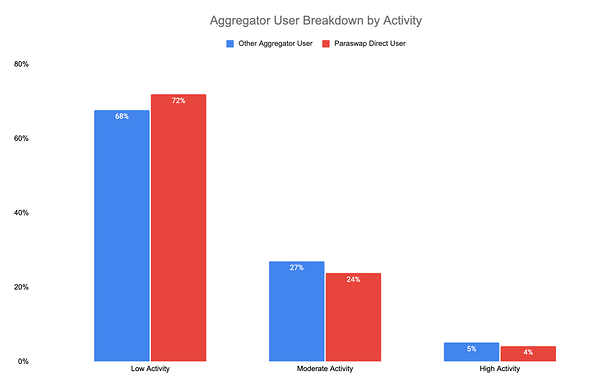
From the perspective of user activity, Paraswap has more low-active users compared to other aggregators. This may be a potential issue that needs to be addressed, and implementing targeted Quests to encourage more activity could be helpful.
Goals
- Attract and engage a larger base of experienced and active users for ParaSwap.
- Educate and familiarize new users with all the features and functionalities offered by ParaSwap.
- Get users aware of PSP 2.0 improvement.
- Encourage users to prioritize ParaSwap as their go-to platform for all their swapping needs on a daily basis.
- Efficaciously guide users from being occasional users (3rd quadrant) to becoming frequent users (1st quadrant) of ParaSwap.
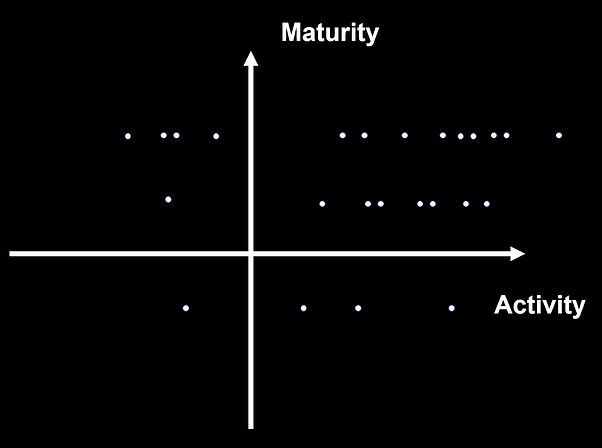
By implementing these strategies, ParaSwap can enhance its user base, improve user retention, and establish itself as the preferred choice for decentralized token swaps.
Please note that the mentioned data is collected on a monthly basis in order to offer a general perspective. However, our quest will be iterated on a weekly basis for quicker feedback loops.
Success Metrics
- Increase in new user acquisition: Tracking the number of new users joining ParaSwap after the implementation of quests.
- Trading volume growth on Optimism: Monitoring the increase in trading volume on the Optimism layer of ParaSwap, a direct result of the quests.
- Staked PSP token amount: Measuring the growth in the amount of PSP tokens (both in sePSP1 and sePSP2) staked by users participating in quests, indicating the engagement level.
- Socially-active behaviors: Observing an upward trend in socially-active behaviors related to quests, such as sharing quests on social media or discussing them in online communities.
- User stickiness and loyalty: Assessing the enhancement of user stickiness and loyalty to ParaSwap, reflected in repeated usage and prolonged engagement with the platform.
- User retention rate improvement: Evaluating the improvement in the retention rate of users who have participated in quests, indicating their satisfaction and continued interest in ParaSwap.
Requested Funding
- We are seeking a grant of $15,000 in OP and matching PSP.
- Of the requested amount, 10% will be distributed to Sixdegree as management fee.
- The rest of the grant funding will be fully utilized to run a series of quests over a period of 3 months.